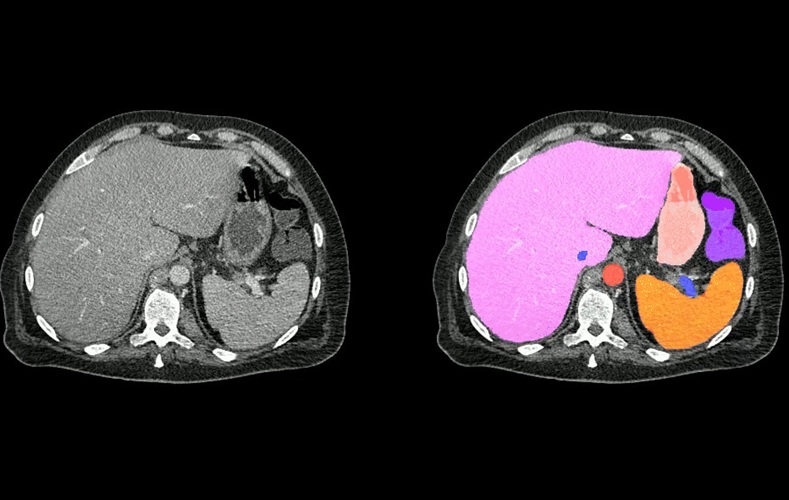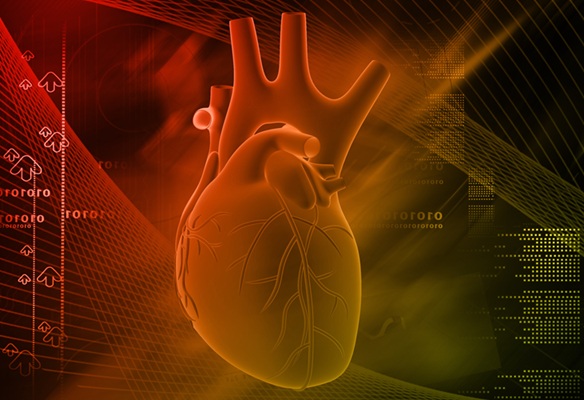AI-Powered Abdomen Map Enables Early Cancer Detection
|
By MedImaging International staff writers Posted on 05 Feb 2025 |

Radiologists are increasingly turning to artificial intelligence (AI)-driven computer vision models to assist with the time-consuming task of analyzing medical scans. However, these models require large, meticulously labeled datasets to produce reliable and accurate results, meaning radiologists still need to spend significant time annotating medical images. To address this challenge, researchers have harnessed AI to create the most extensive and comprehensive dataset of abdominal organs to date, designed to help radiologists quickly and accurately identify tumors and other medical conditions.
A team of researchers from around the globe, led by Johns Hopkins University (Baltimore, MD, USA), has developed AbdomenAtlas, which is the largest abdominal CT dataset available, consisting of more than 45,000 3D CT scans representing 142 annotated anatomical structures. These scans were gathered from 145 hospitals worldwide, making AbdomenAtlas more than 36 times larger than the nearest competitor, TotalSegmentator V2. The dataset and its applications were featured in a recent edition of Medical Image Analysis. Prior abdominal organ datasets were compiled by radiologists manually identifying and labeling individual organs in CT scans, a labor-intensive process requiring thousands of hours of human effort. The researchers accelerated this annotation process by leveraging AI algorithms. With the help of 12 expert radiologists and additional medical trainees, they completed in under two years a task that would have taken human annotators over two millennia.
The method developed by the researchers combines three AI models trained on publicly available datasets of labeled abdominal scans to predict annotations for previously unlabeled scans. The AI then generates color-coded attention maps that highlight areas needing refinement, allowing radiologists to focus their review on the most critical sections of the models' predictions. This iterative process—AI prediction followed by human validation—greatly accelerates the annotation workflow, achieving a 10-fold speedup for tumors and a 500-fold speedup for organ annotations, according to the researchers. This process not only increases the scope, scale, and precision of the dataset, but it also prevents overwhelming the radiologists involved. The outcome is what the team describes as the largest fully annotated abdominal organ dataset available. They are continuing to expand the dataset by adding more scans, organs, and both real and artificial tumors, further enhancing the training of AI models for identifying cancer, diagnosing diseases, and even creating digital twins of real-life patients.
AbdomenAtlas also provides a valuable benchmark that allows other research groups to test the accuracy of their medical segmentation algorithms. The more comprehensive the dataset used to evaluate these algorithms, the more reliable and effective the models can be in complex clinical scenarios, according to the Hopkins team. The researchers plan to make AbdomenAtlas publicly available and are introducing new medical segmentation challenges to encourage AI algorithms that are not only theoretically robust but also practically efficient and reliable for use in clinical settings. Despite the advancements offered by AbdomenAtlas, its creators note that it represents only 0.05% of the CT scans acquired annually in the United States, and they are calling on other institutions to help expand this important resource.
"Cross-institutional collaboration is crucial for accelerating data sharing, annotation, and AI development," the researchers wrote. "We hope our AbdomenAtlas can set the stage for larger-scale clinical trials and offer exceptional opportunities to practitioners in the medical imaging community."
Latest General/Advanced Imaging News
- CT Colonography Beats Stool DNA Testing for Colon Cancer Screening
- First-Of-Its-Kind Wearable Device Offers Revolutionary Alternative to CT Scans
- AI-Based CT Scan Analysis Predicts Early-Stage Kidney Damage Due to Cancer Treatments
- CT-Based Deep Learning-Driven Tool to Enhance Liver Cancer Diagnosis
- AI-Powered Imaging System Improves Lung Cancer Diagnosis
- AI Model Significantly Enhances Low-Dose CT Capabilities
- Ultra-Low Dose CT Aids Pneumonia Diagnosis in Immunocompromised Patients
- AI Reduces CT Lung Cancer Screening Workload by Almost 80%
- Cutting-Edge Technology Combines Light and Sound for Real-Time Stroke Monitoring
- AI System Detects Subtle Changes in Series of Medical Images Over Time
- New CT Scan Technique to Improve Prognosis and Treatments for Head and Neck Cancers
- World’s First Mobile Whole-Body CT Scanner to Provide Diagnostics at POC
- Comprehensive CT Scans Could Identify Atherosclerosis Among Lung Cancer Patients
- AI Improves Detection of Colorectal Cancer on Routine Abdominopelvic CT Scans
- Super-Resolution Technology Enhances Clinical Bone Imaging to Predict Osteoporotic Fracture Risk
- Deep Learning Model Detects Lung Tumors on CT
Channels
Radiography
view channel
AI Detects Fatty Liver Disease from Chest X-Rays
Fatty liver disease, which results from excess fat accumulation in the liver, is believed to impact approximately one in four individuals globally. If not addressed in time, it can progress to severe conditions... Read more
AI Detects Hidden Heart Disease in Existing CT Chest Scans
Coronary artery calcium (CAC) is a major indicator of cardiovascular risk, but its assessment typically requires a specialized “gated” CT scan that synchronizes with the heartbeat. In contrast, most chest... Read moreMRI
view channel
New MRI Technique Reveals Hidden Heart Issues
Traditional exercise stress tests conducted within an MRI machine require patients to lie flat, a position that artificially improves heart function by increasing stroke volume due to gravity-driven blood... Read more
Shorter MRI Exam Effectively Detects Cancer in Dense Breasts
Women with extremely dense breasts face a higher risk of missed breast cancer diagnoses, as dense glandular and fibrous tissue can obscure tumors on mammograms. While breast MRI is recommended for supplemental... Read moreUltrasound
view channel
Wireless Chronic Pain Management Device to Reduce Need for Painkillers and Surgery
Chronic pain affects millions of people globally, often leading to long-term disability and dependence on opioid medications, which carry significant risks of side effects and addiction.... Read more
New Medical Ultrasound Imaging Technique Enables ICU Bedside Monitoring
Ultrasound computed tomography (USCT) presents a safer alternative to imaging techniques like X-ray computed tomography (commonly known as CT or “CAT” scans) because it does not produce ionizing radiation.... Read moreNuclear Medicine
view channel
Novel Bacteria-Specific PET Imaging Approach Detects Hard-To-Diagnose Lung Infections
Mycobacteroides abscessus is a rapidly growing mycobacteria that primarily affects immunocompromised patients and those with underlying lung diseases, such as cystic fibrosis or chronic obstructive pulmonary... Read more
New Imaging Approach Could Reduce Need for Biopsies to Monitor Prostate Cancer
Prostate cancer is the second leading cause of cancer-related death among men in the United States. However, the majority of older men diagnosed with prostate cancer have slow-growing, low-risk forms of... Read moreImaging IT
view channel
New Google Cloud Medical Imaging Suite Makes Imaging Healthcare Data More Accessible
Medical imaging is a critical tool used to diagnose patients, and there are billions of medical images scanned globally each year. Imaging data accounts for about 90% of all healthcare data1 and, until... Read more
Global AI in Medical Diagnostics Market to Be Driven by Demand for Image Recognition in Radiology
The global artificial intelligence (AI) in medical diagnostics market is expanding with early disease detection being one of its key applications and image recognition becoming a compelling consumer proposition... Read moreIndustry News
view channel
GE HealthCare and NVIDIA Collaboration to Reimagine Diagnostic Imaging
GE HealthCare (Chicago, IL, USA) has entered into a collaboration with NVIDIA (Santa Clara, CA, USA), expanding the existing relationship between the two companies to focus on pioneering innovation in... Read more
Patient-Specific 3D-Printed Phantoms Transform CT Imaging
New research has highlighted how anatomically precise, patient-specific 3D-printed phantoms are proving to be scalable, cost-effective, and efficient tools in the development of new CT scan algorithms... Read more
Siemens and Sectra Collaborate on Enhancing Radiology Workflows
Siemens Healthineers (Forchheim, Germany) and Sectra (Linköping, Sweden) have entered into a collaboration aimed at enhancing radiologists' diagnostic capabilities and, in turn, improving patient care... Read more

















.jpeg)



